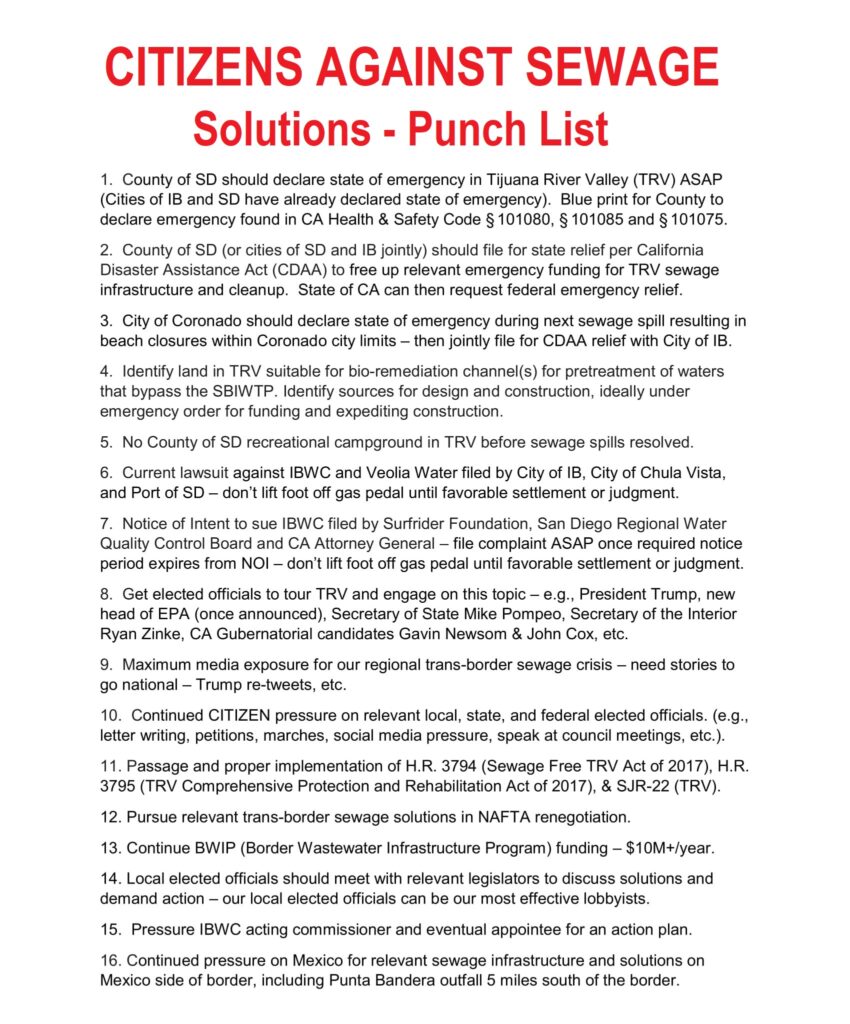Submitted by Daron Case, Esq.
At the State of the City Address on May 24th, Coronado Mayor Richard Bailey stated the City of Coronado had taken a “lead role” to create a “coalition” and identify a “solution” to our regional trans-border sewage crisis that he said would be fixed within a few years. However, no specifics or details were provided. It was not until last week on a social media post by Mayor Bailey and his KUSI interview on the morning of July 11th that we learned Coronado’s solution is retention ponds using grant money available from federal agencies including the EPA.
There are many concerns with Coronado’s solution. Item #4 of the Citizens Against Sewage (CAS) Solutions Punch List is “bio-remediation channels.” Last year, CAS was promoting “retention ponds” (i.e., “catch basins” or “retention basins”), but when it became clear Border Patrol (BP) did not want their agents having to contend with bodies of water in the Tijuana River Valley (TRV), CAS switched to “bio-remediation channels” which is more like a creek that can be walked over. Bio-remediation channels would not be a hazard to BP agents, and CAS would only promote solutions with BP input.
The “coalition” Coronado has created does not include the City of Imperial Beach (the city most adversely affected by trans-border sewage) nor local non-governmental organizations (NGO’s) such as Surfrider, Wildcoast, or CAS who have been working for years on solutions to our regional trans-border sewage crisis. Because the City of Coronado is not working with other local stakeholders (other than the County of San Diego who local NGO’s recently protested for the County’s inaction on the sewage crisis), Coronado came up with an outdated concept from last year which is duplicative of strategies already in motion. Retention basins are a solution mainly for dry weather spills. However, due to pressure from mounting lawsuits against the International Boundary & Water Commission (IBWC), mechanical and electrical upgrades at pump station CILA #1 (on Mexico side of border) were made which have essentially put an end to dry weather spills – there have been no dry weather flows for over 3 months in the TRV since these major upgrades. When there is a substantial wet weather event, the flow capacity of the Tijuana River is approximately one billion gallons per day – a catch basin cannot treat the flow from a substantial wet weather event.
Another concern is funding. CAS has identified funding for bio-remediation channels – i.e., having the County declare a state of emergency and file for state relief per the California Disaster Assistance Act (CDAA). CAS recently protested the County asking them to declare a state of emergency, which they have failed to do. In the absence of the County declaring a state of emergency and filing for CDAA funding, two local municipalities can jointly file. CAS has encouraged the cities of San Diego and Imperial Beach, both that have already declared a state of emergency, to file for CDAA funding. CAS also encouraged the City of Coronado to declare a state of emergency during the last sewage spill closing Coronado beaches so Coronado could jointly file for CDAA funding with Imperial Beach. However, like San Diego County, Coronado did not declare a state of emergency. The emergency declaration is important because it would expedite the construction and development of any infrastructure solutions including catch basins. Even if Coronado’s plan to obtain grant money succeeds, without an emergency order we’re looking at several years before all relevant studies (e.g., CEQA & EIR) and infrastructure construction is completed.
Finally, the current and biggest threat now in our regional transboundary sewage crisis is the Punta Bandera treatment facility and outfall 5 miles south of the border, which produces approximately 25 million gallons of wastewater flowing into the ocean every day. With a south swell as we often see in summer and fall seasons, the effluent from Punta Bandera can be pushed north to IB and Coronado. A catch basin on the U.S. side of the border can do nothing to prevent the biggest threat at Punta Bandera.
It seems Coronado should go back to the drawing board with respect to their solution to transboundary sewage. I would recommend the City of Coronado include stakeholders such as City of IB and local NGO’s in their “coalition” think tank, so outdated solutions are not identified and publicly promoted going forward.
Daron A. Case, Esq. – Attorney with Citizens Against Sewage





